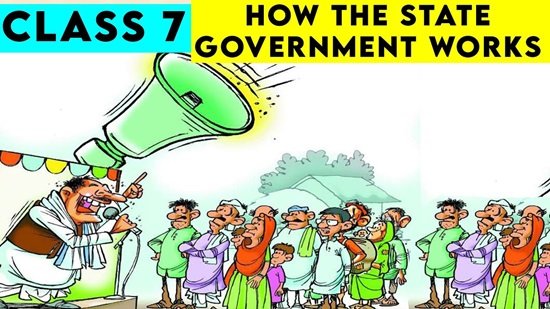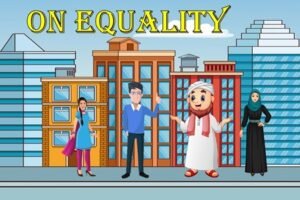
Chapter 3: HOW THE STATE GOVERNMENT WORKS
HOW THE STATE GOVERNMENT WORKS

HOW THE STATE GOVERNMENT WORKS:
HOW THE STATE GOVERNMENT WORKS, India is a democratic country where people choose their own representatives. Since the country is divided into various states, the people not only elect the members of the Central Government but also choose the Government of the State in which they live.
Elections in the State
- In India, every state has a government which looks after the administration of that state. The state is divided into several areas or constituencies.
- Every state has a different number of constituencies depending upon its size.
- While Sikkim has 32 legislative constituencies, the state of Uttar Pradesh has 403, which is the highest number of legislative constituencies in any state,
- People elect one representative from each constituency who represents them in the State Legislative Assembly.
- A person who gets elected from a constituency in the state elections becomes a Member of Legislative Assembly or a MLA.
- The MLAs elected may belong to different political parties.
- A political party whose MLAs win more than half of the seats in the Assembly elections of a state becomes the ruling party and forms the government in that state. The MLAs belonging to the other political parties become the ‘Members of the Opposition’.
- After the elections, the MLAs of the ruling party elect their leader (who has also been elected as MLA), to become the Chief Minister.
- The Chief Minister in turn elects the other ministers, who look after the various departments.
- In a Legislative Assembly, all the elected MLA’s belonging to the ruling and opposition parties meet and discuss the laws and the working of the government.
- An MLA who is also a minister has to not only look after the working of his department but also the development of the constituency from which he is elected.
- While the government looks after the overall development of the state, a MLA looks after the development of the constituency from which he/she is elected.
- An Act can become a law only when it is passed by the members of the Legislative Assembly. Members can discuss and debate and ask questions about the working of the government.
Powers and functions of Legislative Assembly
The legislative assembly has mainly two types of powers. These are Legislative and Financial powers.
The Legislative Power: The subjects of administration are divided into three lists. These are union list, state list and concurrent list. The legislative assembly makes law for subjects mentioned, in the state list and the concurrent list.
The Financial Power: The assembly passes the state budget, money bills, permission for levying taxes and fixing salaries of the members of state legislature.
Money bills are always introduced in the legislative assembly.
How Does A Bill Become A Law
There are two types of bills: Money bill and Non-money bill. Money bill is introduced in the legislative assembly and the non-money bill can be introduced either in Legislative Assembly or Legislative Council. There are three stages for a bill to be passed.
- First Stage: In this stage the bill in introduced and its title is read out to the members.
- Second Stage: The house refers the bill to the selected committees where a detailed discussion is held. This is called second reading.
- Third stage: In the third reading, the bill goes to the other house and the same procedure is followed.
After a stipulated time of 3 months the bill is considered to be passed by both the houses. Finally it goes to the governor for his consent. In case of money bills, Legislative Council can make recommendations. It can delay the bill for 14 days only but it should be passed in Legislative Assembly after the 14 days.
Opposition party :
The elected representatives who are not the members of the ruling party belong to the opposition party. The representative together plays the role of questioning government decisions and actions. They also raise new issues for consideration in the Assembly.
Ruling party :
The political party that has the majority is known as the ruling party.
Press conference :
A gathering of media persons who are invited to hear about and ask questions on a particular issue and are then expected to report on this to the larger public.
Powers of the governor:HOW THE STATE GOVERNMENT WORKS
Executive powers: The leader of the majority party is appointed as Chief Minister by the Governor. He also appoints the other ministers. He appoints other top officials such as Advocate General and members of State Public Service Commission.
Discretionary power: The Governor works on the advice of the council of ministers. In certain situations he is forced to take independent decisions, which is called the discretionary power. At times when the state is under the President’s rule he can take a discretionary decision.
Legislative power: The Governor inaugurates the first session of the assembly after the elections. Every bill passed by the Legislative Assembly, should have his approval. He can pass ordinance or a law in case the assembly is not in session.
Financial Power: No money bill or budget can be introduced in the house without the Governor’s approval.
Judicial power: Governor can grant pardon or reduce the punishment of people convicted under the state laws.
The first woman Governor of independent India was Sarojini Naidu. She was appointed as Governor of Uttar Pradesh in 1947.
Chief minister and his council of ministers
All powers regarding the administration of state are vested with the Chief Minister and his ministry. He remains in power as long as he enjoys the support of the members.
Power and Functions of Chief Minister Chief minister is the leader of the ruling political party which has got majority in the election. He is a vital link between the Governor and the Council of ministers. Each minister is individually and collectively answerable to him. His main powers are : –
- Determines the policies.
- Supervises the administration of the state.
- Allocates portfolio to all ministers.
- Coordinates the work of the council of ministers.
Powers and Functions of the Council of Ministers The administration of a state takes place through various departments and different ministers are responsible for the portfolios. The main function is to run the departments according to the policies laid down by the Council of ministers. They bring bills in the assembly for discussion and approval.
The Working of the Government:HOW THE STATE GOVERNMENT WORKS
- The Chief Minister is the Executive Head of the State who supervises the works of the various ministers.
- The Ministers of the State head different departments such as the Health, Agriculture, Education, Revenues, Public Works Department etc. They formulate the policies and supervise the working of their department.
- The government can pass new laws for the state on various matters such as education, health and sanitation.
- The ministers also have to answer the questions put to them by the members of the opposition party regarding the working of their departments.
- Media such as television networks and newspapers discuss several issues regarding the working of the ministers and their departments. Any harmful policy can lead to debates and heated discussions in the public forum.
- The government has to respond to the various issues. They not only answer the questions asked by the members of opposition in the legislature but also hold press conferences to explain and defend certain decisions taken by them.
We find that people are supreme in a democracy. They elect their own representatives in the State Elections. If an MLA does not work up to the expectations of the people, the people may not vote for him/ her in the next general elections. Therefore, people have the main authority in the State Elections.
Important Questions of HOW THE STATE GOVERNMENT WORKS
- Multiple Choice Questions :HOW THE STATE GOVERNMENT WORKS
Question 1. The head of the executive is:
(a) Governor
(b) Minister
(c) Chief minister
Question 2. Government works at levels:
(a) 4
(b) 3
(c) 2
Question 3. How many assembly constituencies Himachal Pradesh has?
(a) 56
(b) 68
(c) 67
Question 4. An MLA is elected by the:
(a) People
(b) Government
(c) Chief minister
Question 5. Who appoints the chief minister and other minister?
(a) Prime minister
(b) MLA
(c) Governor
Question 6. Ministers and their portfolio are decided by:
(a) Chief minister
(b) Prime minister
(c) Governor
Question 7. what do you mean by Legislature?
(a) Member of opposition party
(b) Member in legislative assembly
(c) Member in ruling party
(d) None of these
Question 8. what does MLAs dual responsibilities mean?
(a) As a MLA
(b) As a minister
(c) Both a and b
(d) None of these
Question 9. what name is given to the elected representatives who are not member of ruling party?
(a) Opposition
(b) Constituency
(c) Majority
(d) Press conference
Question 10. Who becomes the chief minister?
(a) Leader of the winning party
(b) Leader of the losing party
(c) Prime minister of the country
(d) President of the country
Question 11. what is the full form of MLA?
(a) Member of Law Authority
(b) Member of Legal Arm
(c) Member of Legislative Assembly
(d) Member of Legislative Arm
Question 12. What do you mean by majority?
(a) Situation when more than half the number is on one idea
(b) Situation when less than half the number is on one idea
(c) Situation of equal voting
(d) None of these
Question 13. What were organized by the assembly to discuss about government work?
(a) Live session
(b) Press conference
(c) Janta polls
(d) none of these
Question 14. What do you mean by coalition?
(a) Group of poor farmers
(b) Group of rich merchants
(c) Group of parties working together
(d) None of these
Question 15. By whom the governor is appointed?
(a) MLA
(b) Central Government
(c) President
(d) None of these
- Fill in the blanks :HOW THE STATE GOVERNMENT WORKS
- The head of the state is the _________.
- ORS packets are given to those who are suffering from ________.
- The governor of the state is appointed by the ______ government.
- ______ is the leader of the ruling party.
- Every MLA is elected from one are(a) This area is known as ______.
- Write true (T) or false (F) HOW THE STATE GOVERNMENT WORKS
- Some MLAs have dual responsibilities: one as an MLA and the other as a minister.
- In a monarchy, people organise meetings to voice their opinions and protest against the government.
- Members of the Legislative Assembly (MLAs) are elected by the people.
- Very Short Questions :HOW THE STATE GOVERNMENT WORKS
- How is the Governor of a state appointed?
- Whose responsibility is it to nm various government departments or ministers?
- How will you define a Legislative Assembly?
- Define the term ‘government’.
- Who is the head of the executive?
- Why did the Chief Minister and the minister for health visit Patalpwam district?
- Why are press conferences organised?
- What do you know about a wallpaper?
- Why do people in a democratic set up organise meetings?
- The government works at three levels. Name them.
- Short Questions HOW THE STATE GOVERNMENT WORKS
- Define the term press conference.
- Explain the following terms–majority, ruling party, opposition.
- Explain the responsibility of a chief minister after election of MLAs.
- What is role of the party that does not form government?
- Who becomes a Chief Minister? What is his/her role in a state?
- Long Questions :HOW THE STATE GOVERNMENT WORKS
- How does a government function in a state?
- What do you mean by an MLA? Is it necessary to become a member of any political party to become an MLA?
- What is the process of formation of government in a state?
- How do the people in power like the chief minister and the minister take action?
- How did some MLAs become Ministers? Explain.
ANSWER KEY –
- Multiple Choice Answer :HOW THE STATE GOVERNMENT WORKS
- (c) Chief minister
- (b) 3
- (b) 68
- (a) People
- (c) Governor
- (a) Chief minister
- (b) Member in legislative assembly
- (c) Both a and b
- (a) Opposition
- (a) Leader of the winning party
- (c) Member of Legislative Assembly
- (a) Situation when more than half the number is on one idea
- (b) Press conference
- (c) Group of parties working together
- (b) Central Government
- Fill in the blanks :HOW THE STATE GOVERNMENT WORKS
- Governor
- diarrhoea
- central
- Chief minister
- constituency
- Write true (T) or false (F) :HOW THE STATE GOVERNMENT WORKS
- True
- False
- True
- Very Short Answer :HOW THE STATE GOVERNMENT WORKS
- The Governor of a state is appointed by the Central Government.
- It is the responsibility of the Chief Minister and other ministers to run various government departments or ministers.
- A Legislative Assembly is a place where all the MLAs, from the ruling party as well as the opposition, meet to discuss various things.
- The term ‘government’ refers to the government departments and various ministers who head them.
- The Chief Minister is the head of the executive.
- They went to visit the families who had lost their relatives due to the spread of diarrhoea. They also visited people in the hospitals.
- Press conferences are oraganised to discuss various current issues.
- A wallpaper is an interesting activity through which research can be done on particular topics of interest.
- They do so to voice their opinions and protest against the government if any of its actions is not in their favour.
- The government works at three levels namely:
- Local
- State
- Natural
- Short Answer :HOW THE STATE GOVERNMENT WORKS
- Press conference is a gathering of journalists from the media who are invited to hear about and ask questions on a particular issue and are then expected to report on this to the larger public.
- A political party whose MLAs have won more than half the number of constituencies in a state can be said to be in a majority. The political party that has the majority is called the ruling party and all other members are called the opposition.
- After the elections, the MLAs of the ruling party elect their leader who becomes the chief minister. The chief ministers select other ministers.
- As per the Constitution all the parties which do not take part in the formation of government are called opposition parties. In our democratic set up the role of the opposition parties is in no way less important than the ruling party. The opposition parties keep a watch over the functioning of the ruling party. They take part in every discussion and debate held in the Assembly. They can check and protest any wrong action of the government.
- Chief Minister is the leader of the ruling party. He/She is elected out of the total members of the party gaining majority in the general election. He/she is the executive head of the government. He/She is responsible for every action of the government. He/she also coordinates between the government at the centre and the state.
- Long Answer :HOW THE STATE GOVERNMENT WORKS
- A government is headed by the Chief Minister. The Chief Minister, in order to manage the functioning of the government, appoints ministers at various levels like cabinet ministers, state ministers and deputy ministers. Every government departments is headed by a cabinet minister who is directly accountable for the functioning of the particular department. The heads of the government departments who are bureaurates, are responsible for the handling of the government decisions. The bureaurates project and get the works completed. The ministers give approval to the works.
- The term MLA stands for a Member of Legislative Assembly. He/She is elected through a general election and represents a particular constituency. It is not necessary for one to be a member of a political party to become a MLA. He/she can contest the election as an independent candidate also. In some cases, he/ she is sponsored by a political party. But one thing is necessary that he/she must be a citizen of India and fulfil the requisite qualifications for the post.
- A general election is conducted to elect representatives from various constituencies. The party which earns more than half of the total seats is said to be in a majority. That party is usually called for forming the government.
Sometimes, no party gains clear majority. In that case the party with maximum elected members tries to get support from the like-minded parties or independent candidates. The party that proves to have maximum supporters in that way is allowed to form government. Otherwise there would be re-election.
- They do so through various departments like the Public Works Department, the Agriculture Department, the Health Department, the Education Department and so on. They also have to answer questions that are asked in the Legislative Assembly and convince people asking the questions that proper steps are being taken. At the same time, newspapers and the media widely discuss the issue and the government has to respond, for example, by holding the press conferences.
- After the elections, a political party whose MLAs have won more than half the number of constituencies in a state can be said to be in a majority. The political party that has the majority is called the ruling party and all other members are called the opposition. The MLAs belonging to the ruling party will elect their leader who will become the chief minister. The chief minister then selects other people as ministers. After the elections, it is the Governor of the state who appoints the chief minister and other ministers.



